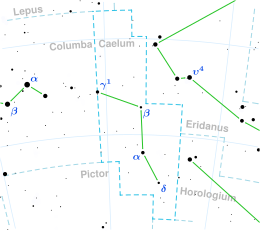Beta Caeli
| Observation data Epoch J2000.0 Equinox J2000.0 (ICRS) | |
|---|---|
| Constellation | Caelum |
| Right ascension | 04h 42m 03.48230s[1] |
| Declination | −37° 08′ 39.5889″[1] |
| Apparent magnitude (V) | 5.04[2] |
| Characteristics | |
| Spectral type | F3 V[3] or F3 IV[4] |
| U−B color index | +0.01[2] |
| B−V color index | +0.38[2] |
| Astrometry | |
| Radial velocity (Rv) | 27.47±0.24[5] km/s |
| Proper motion (μ) | RA: +42.561 mas/yr[5] Dec.: +212.705 mas/yr[5] |
| Parallax (π) | 34.6088 ± 0.0531 mas[5] |
| Distance | 94.2 ± 0.1 ly (28.89 ± 0.04 pc) |
| Absolute magnitude (MV) | +2.64[6] |
| Details | |
| β Cae A | |
| Mass | 1.482±0.040[5] M☉ |
| Radius | 1.902+0.001 −0.004[5] R☉ |
| Luminosity | 6.615+0.020 −0.019[5] L☉ |
| Surface gravity (log g) | 3.981+0.003 −0.002[5] cgs |
| Temperature | 6,665.7+1.6 −1.4[5] K |
| Metallicity [Fe/H] | −0.12[3] dex |
| Rotation | 0.8669±0.0013[7] days |
| Rotational velocity (v sin i) | 97.5±4.9[6] km/s |
| Age | 0.2 or 1.17[7] Gyr 1.941±0.307[5] Gyr |
| β Cae B | |
| Mass | 0.08 or 0.2[7] M☉ |
| Temperature | 3,593±160[7] K |
| Orbit[7] | |
| Primary | A |
| Companion | B |
| Period (P) | 7.5 yr |
| Semi-major axis (a) | 4.6 AU |
| Eccentricity (e) | 0.6 |
| Inclination (i) | 27 or 153° |
| Longitude of the node (Ω) | 151° |
| Argument of periastron (ω) (secondary) | 38° |
| Other designations | |
| Database references | |
| SIMBAD | data |
Beta Caeli (β Caeli, abbreviated to β Cae) is a star in the southern constellation of Caelum. It is a dim star but visible to the naked eye, having an apparent visual magnitude of 5.04.[2] Based upon an annual parallax shift of 34.6 mas as seen from Earth,[5] it is located at a distance of 94 light years. The star is moving away from the Sun with a radial velocity of +27.5 km/s.[5]
Characteristics
[edit]This is a spectroscopic binary star system; possibly a single-lined binary, meaning the spectral lines of only one star can be seen.[8] The main component has a stellar classification of F3 V[3] or F3 IV,[4] indicating it is either an F-type main-sequence star or a somewhat more evolved subgiant star, respectively. It has an estimated 1.5 times the mass of the Sun and about 1.9 times the Sun's radius.[5] The star is 200 million[7] to two billion years old[5] and has a high rate of spin with a projected rotational velocity of around 97.5 km/s.[6]
The companion is a low-mass star orbiting about 5 AU from the primary, with an orbital period around seven years. Its exact mass is uncertain; an orbital solution suggest it is close to the brown dwarf regime at around 0.08 M☉, but models of stellar atmospheres suggest a higher mass of 0.2 M☉.[7] It was first detected in 2017 and was believed to be either a brown dwarf or a star with minimum mass around 40 Jupiter masses.[8] In 2022, Beta Caeli was imaged with the Gemini Planet Imager, with a point source that very likely is β Caeli B been detected.[7] This object may be the source of the X-ray emission coming from the same location.[8]
The existence of additional companions beyond 55 astronomical units is ruled out.[8]
See also
[edit]- Alpha Caeli
- Alpha Trianguli, similar configuration
References
[edit]- ^ a b c "bet Cae". SIMBAD. Centre de données astronomiques de Strasbourg. Retrieved 2017-09-09.
{{cite web}}: CS1 maint: postscript (link) - ^ a b c d Cousins, A. W. J. (1973), "UBV photometry of some southern stars", Monthly Notes of the Astronomical Society of Southern Africa, 32: 11, Bibcode:1973MNSSA..32...11C.
- ^ a b c Gray, R. O.; et al. (July 2006), "Contributions to the Nearby Stars (NStars) Project: spectroscopy of stars earlier than M0 within 40 pc-The Southern Sample", The Astronomical Journal, 132 (1): 161–170, arXiv:astro-ph/0603770, Bibcode:2006AJ....132..161G, doi:10.1086/504637, S2CID 119476992.
- ^ a b Torres, C. A. O.; et al. (December 2006), "Search for associations containing young stars (SACY). I. Sample and searching method", Astronomy and Astrophysics, 460 (3): 695–708, arXiv:astro-ph/0609258, Bibcode:2006A&A...460..695T, doi:10.1051/0004-6361:20065602, S2CID 16080025.
- ^ a b c d e f g h i j k l m Vallenari, A.; et al. (Gaia collaboration) (2023). "Gaia Data Release 3. Summary of the content and survey properties". Astronomy and Astrophysics. 674: A1. arXiv:2208.00211. Bibcode:2023A&A...674A...1G. doi:10.1051/0004-6361/202243940. S2CID 244398875. Gaia DR3 record for this source at VizieR.
- ^ a b c Ammler-von Eiff, Matthias; Reiners, Ansgar (June 2012), "New measurements of rotation and differential rotation in A-F stars: are there two populations of differentially rotating stars?", Astronomy & Astrophysics, 542: A116, arXiv:1204.2459, Bibcode:2012A&A...542A.116A, doi:10.1051/0004-6361/201118724, S2CID 53666672.
- ^ a b c d e f g h García, Luciano H; Petrucci, R; Jofré, E; Gómez, M (2022-08-17), "High-contrast imaging of HD 29992 and HD 196385 with the Gemini Planet Imager", Monthly Notices of the Royal Astronomical Society, 515 (4): 4999–5008, arXiv:2207.07435, doi:10.1093/mnras/stac1929, ISSN 0035-8711
- ^ a b c d Borgniet, Simon; et al. (2017), "Extrasolar planets and brown dwarfs around AF-type stars. IX. The HARPS southern sample", Astronomy & Astrophysics, 599: A57, arXiv:1608.08257, Bibcode:2017A&A...599A..57B, doi:10.1051/0004-6361/201628805, S2CID 118723455.

